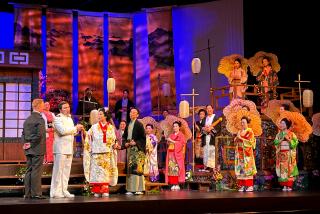Music and Dance Reviews : Oregon Ballet Theatre at Whittier High School
Neither an outpost for experimentalism nor a spawning ground for works of great substance, Oregon Ballet Theatre is like many other regional companies in the land--it follows in the path of Balanchine, nods to Arpino and dabbles in novelty.
That impression, at least, sums up the 23-member company as it appeared Sunday afternoon in the Whittier High School Auditorium. And predictably so with James Canfield and Dennis Spaight, who lead the ensemble (formed from the merging of Ballet Oregon and Pacific Ballet Theatre), as alumni of those style-setters.
The question then comes down to how well the format is followed. The answer: most respectably, in terms of both the repertory and the dancing.
As resident choreographer, Spaight contributed 80% of the program and proved to be a versatile craftsman who knows his way around the various ballet avenues.
If he didn’t quite conjure the magic of a Faberge egg in his “Haydn Quartet,” a tutu and tiara ballet--suggesting instead a bland but tasteful exercise in classical ritual--part of the blame fell to dancers not bred in the imperial tradition.
But when it came to an idiom more natural to their habitat--the pas de deux from “Tryptych,” for example--there could be no quibble. Here Spaight capitalized on picturesque stretchings and twistings, lifts and poses--all the body intertwinings that comprise the best of Arpino.
This particular bit, with Tracy Taylor and Tom Teague undulating in their shiny spandex unitards, made a striking visual effect.
So did Bruce Marks’ “The Lark Ascending.” It bore similar signs: bare-chested men and the single woman in slinkwear. But against the wistful lyricism of the Ralph Vaughan Williams score, this bird of paradise, danced by an affecting Michelle Hornbeak, had a dramatic crux.
“Rhapsody in Blue”--Spaight’s version of Balanchine’s “Who Cares?”--made an apt closing number. Its smart and saucy balleticisms showed the full ensemble to advantage and Gershwin’s music even afforded some narrative byplay.
More to Read
The biggest entertainment stories
Get our big stories about Hollywood, film, television, music, arts, culture and more right in your inbox as soon as they publish.
You may occasionally receive promotional content from the Los Angeles Times.










